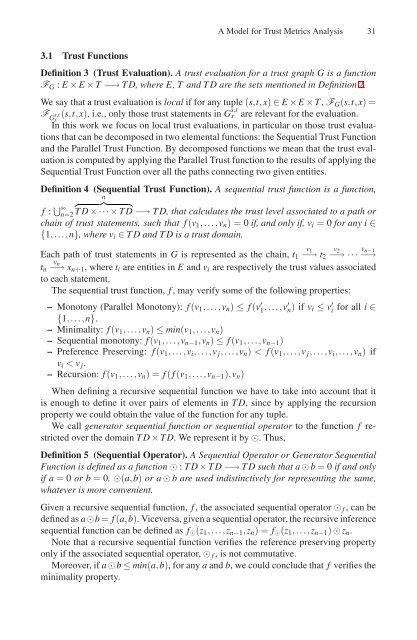Lecture Notes in Computer Science 5185
Lecture Notes in Computer Science 5185
Lecture Notes in Computer Science 5185
Create successful ePaper yourself
Turn your PDF publications into a flip-book with our unique Google optimized e-Paper software.
A Model for Trust Metrics Analysis 31<br />
3.1 Trust Functions<br />
Def<strong>in</strong>ition 3 (Trust Evaluation). A trust evaluation for a trust graph G is a function<br />
FG : E × E × T −→ TD, where E, T and T D are the sets mentioned <strong>in</strong> Def<strong>in</strong>ition 2.<br />
We say that a trust evaluation is local if for any tuple (s,t,x) ∈ E × E × T, FG(s,t,x)=<br />
F s,t<br />
G (s,t,x), i.e., only those trust statements <strong>in</strong> Gs,t x are relevant for the evaluation.<br />
x<br />
In this work we focus on local trust evaluations, <strong>in</strong> particular on those trust evaluations<br />
that can be decomposed <strong>in</strong> two elemental functions: the Sequential Trust Function<br />
and the Parallel Trust Function. By decomposed functions we mean that the trust evaluation<br />
is computed by apply<strong>in</strong>g the Parallel Trust function to the results of apply<strong>in</strong>g the<br />
Sequential Trust Function over all the paths connect<strong>in</strong>g two given entities.<br />
Def<strong>in</strong>ition 4 (Sequential Trust Function). A sequential trust function is a function,<br />
f : � n<br />
� �� �<br />
∞<br />
n=2 TD×···×TD −→ T D, that calculates the trust level associated to a path or<br />
cha<strong>in</strong> of trust statements, such that f (v1,...,vn) =0 if, and only if, vi = 0 for any i ∈<br />
{1,...,n},wherevi∈TDand TD is a trust doma<strong>in</strong>.<br />
Each path of trust statements <strong>in</strong> G is represented as the cha<strong>in</strong>, t1 −→ t2 −→ ··· vn−1<br />
−→<br />
tn vn<br />
−→ xn+1, wheretiare entities <strong>in</strong> E and vi are respectively the trust values associated<br />
to each statement.<br />
The sequential trust function, f , may verify some of the follow<strong>in</strong>g properties:<br />
– Monotony (Parallel Monotony): f (v1,...,vn) ≤ f (v ′ 1 ,...,v′ n ) if vi ≤ v ′ i for all i ∈<br />
{1,...,n}.<br />
– M<strong>in</strong>imality: f (v1,...,vn) ≤ m<strong>in</strong>(v1,...,vn)<br />
– Sequential monotony: f (v1,...,vn−1,vn) ≤ f (v1,...,vn−1)<br />
– Preference Preserv<strong>in</strong>g: f (v1,...,vi,...,v j,...,vn) < f (v1,...,v j,...,vi,...,vn) if<br />
vi < v j.<br />
– Recursion: f (v1,...,vn)= f ( f (v1,...,vn−1),vn)<br />
When def<strong>in</strong><strong>in</strong>g a recursive sequential function we have to take <strong>in</strong>to account that it<br />
is enough to def<strong>in</strong>e it over pairs of elements <strong>in</strong> TD, s<strong>in</strong>ce by apply<strong>in</strong>g the recursion<br />
property we could obta<strong>in</strong> the value of the function for any tuple.<br />
We call generator sequential function or sequential operator to the function f restricted<br />
over the doma<strong>in</strong> TD× TD. We represent it by ⊙. Thus,<br />
Def<strong>in</strong>ition 5 (Sequential Operator). A Sequential Operator or Generator Sequential<br />
Function is def<strong>in</strong>ed as a function ⊙ : TD× TD−→ TD such that a ⊙ b = 0 if and only<br />
if a = 0 or b = 0. ⊙(a,b) or a ⊙ b are used <strong>in</strong>dist<strong>in</strong>ctively for represent<strong>in</strong>g the same,<br />
whatever is more convenient.<br />
Given a recursive sequential function, f , the associated sequential operator ⊙ f , can be<br />
def<strong>in</strong>ed as a⊙b = f (a,b). Viceversa, given a sequential operator, the recursive <strong>in</strong>ference<br />
sequential function can be def<strong>in</strong>ed as f⊙(z1,...,zn−1,zn)= f⊙(z1,...,zn−1) ⊙ zn.<br />
Note that a recursive sequential function verifies the reference preserv<strong>in</strong>g property<br />
only if the associated sequential operator, ⊙ f , is not commutative.<br />
Moreover, if a ⊙ b ≤ m<strong>in</strong>(a,b),foranya and b, we could conclude that f verifies the<br />
m<strong>in</strong>imality property.<br />
v1<br />
v2

















